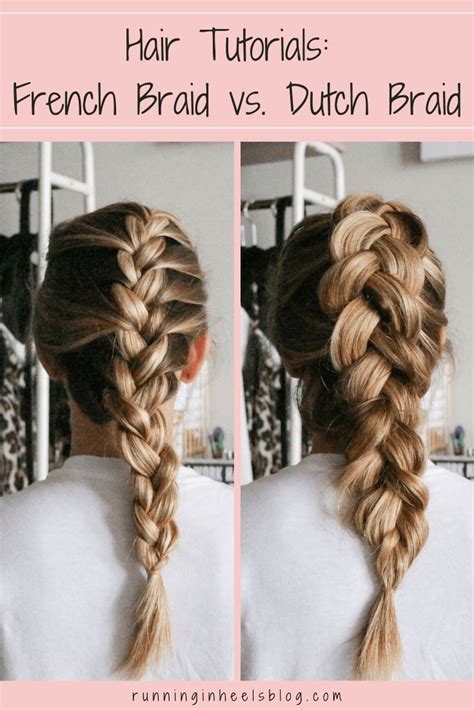When it comes to the world of hairstyling, Dutch braids and French braids stand out as two of the most iconic and versatile braiding techniques. Both styles involve intricately interwoven strands of hair, but their subtle differences create distinct looks and cater to diverse preferences. In this comprehensive guide, we delve into the depths of Dutch braids and French braids, exploring their history, characteristics, benefits, techniques, and suitability for different face shapes and hair types.

History and Cultural Significance
Dutch Braids
Dutch braids, also known as “underbraids” or “inside-out braids,” have their origins in the Netherlands, where they gained popularity in the 17th century. Dutch women traditionally wore these braids as a symbol of marital status and social standing.
French Braids
French braids, on the other hand, trace their roots back to France in the 19th century. They swiftly gained international recognition as a sophisticated and elegant hairstyle, favored by both commoners and royalty alike.
Key Characteristics
Dutch Braids
- Sections of hair are crossed under the previous strand instead of over it, creating a raised effect.
- Result in a more voluminous and textured braid.
- Can appear more casual and sporty.
French Braids
- Sections of hair are crossed over the previous strand, creating a flat and smooth braid.
- Result in a more intricate and refined braid.
- Can appear more formal and sophisticated.
Benefits
Dutch Braids
- Create volume and lift at the roots, making them ideal for fine or thin hair.
- Can help hide bald spots or thinning hair.
- Suitable for various face shapes, especially those with round or square faces.
French Braids
- Help keep hair out of the face and prevent tangles.
- Can be adorned with hair accessories for a more decorative look.
- Versatile enough for both casual and formal occasions.
Techniques
Dutch Braids
- Divide hair into three equal sections.
- Cross the left section under the middle section, then cross the right section under the new middle section.
- Add a thin strand of hair from the left side and cross it under the right section.
- Repeat steps 2 and 3, adding hair from each side, until you reach the nape of the neck.
- Finish the braid in a traditional three-strand braid.
French Braids
- Divide hair into three equal sections.
- Cross the left section over the middle section, then cross the right section over the new middle section.
- Add a thin strand of hair from the left side and cross it over the right section.
- Repeat steps 2 and 3, adding hair from each side, until you reach the end of the hair.
- Secure the braid with a hair tie.
Suitability for Different Face Shapes and Hair Types
Face Shapes
- Dutch Braids: Round, square, oval
- French Braids: Oval, diamond, heart
Hair Types
- Dutch Braids: Fine, thin, medium
- French Braids: All hair types
Applications and Extensions
Dutch braids and French braids have a wide range of applications, both practical and decorative. They can be used to:
- Create intricate hairstyles for special occasions (weddings, proms, etc.)
- Keep hair out of the face during physical activities (sports, workouts, etc.)
- Protect hair from damage caused by sunlight, humidity, or wind
- Add volume and texture to hair that is naturally flat or fine
Motivations of Customers
Customers seeking Dutch braids or French braids often have specific motivations and desires:
Dutch Braids
- To create a youthful and casual look
- To add volume and lift to thin or fine hair
- To cover up bald spots or thinning hair
- To protect hair from damage during sports or outdoor activities
French Braids
- To achieve a sophisticated and elegant hairstyle
- To keep hair out of the face while working or studying
- To add a decorative touch to everyday hairstyles
- To protect hair from damage caused by sunlight or environmental factors
Challenges and Solutions
Challenges
- Dutch Braids: Can be difficult to master for beginners, especially if hair is fine or slippery.
- French Braids: Requires practice and patience to create a smooth and even braid.
Solutions
- Use hairspray or mousse to add texture to hair before braiding.
- Practice regularly to improve technique and coordination.
- Watch video tutorials or seek professional assistance from a hairstylist.
Industry Statistics and Market Potential
The global hair braiding market is estimated to reach $2 billion by 2027, with Dutch braids and French braids accounting for a significant share of this growth. The increasing popularity of social media and online tutorials has led to a surge in demand for these braiding styles.
Innovation and New Applications
Braided Headbands
Dutch braids or French braids can be combined to create stylish and functional braided headbands that keep hair out of the face while adding a touch of flair.
Braided Ponytails
A Dutch braid or French braid can be incorporated into a ponytail to elevate the look and add interest.
Braided Updos
Dutch braids or French braids can be used as the foundation for intricate updos, creating a variety of elegant and sophisticated hairstyles.
Conclusion
Dutch braids and French braids are two timeless braiding techniques that cater to a wide range of preferences and hair types. With their distinct characteristics and benefits, these braiding styles continue to captivate hairstylists and fashion-forward individuals alike. Whether seeking a casual and youthful look or a sophisticated and elegant hairstyle, Dutch braids and French braids offer endless possibilities for creative expression.
